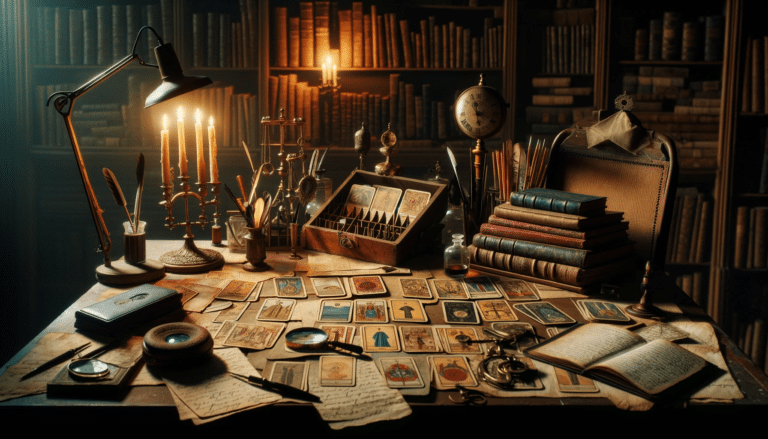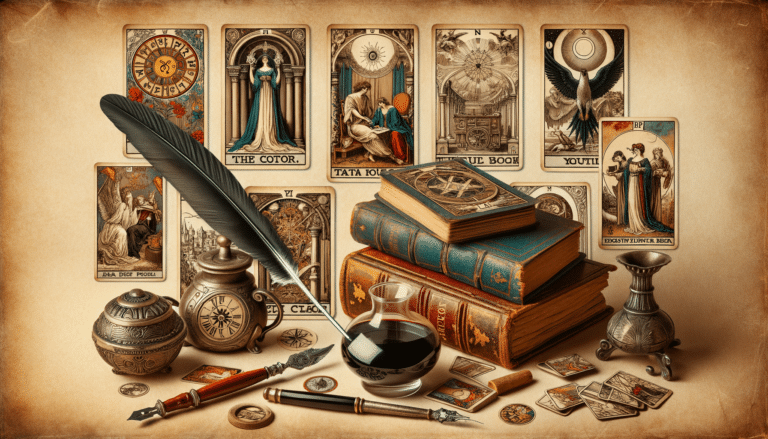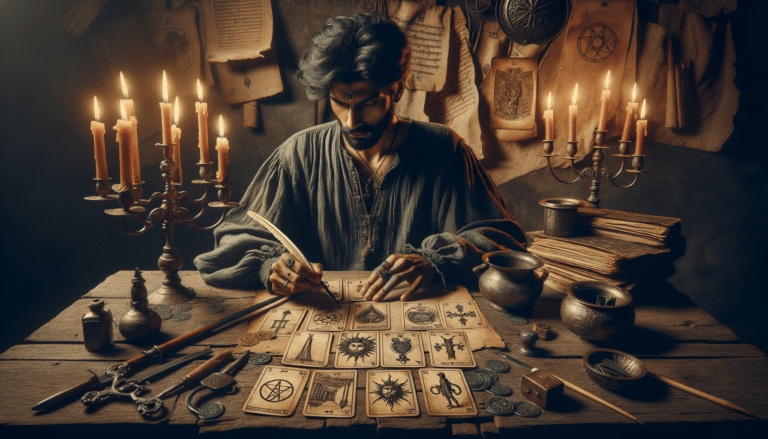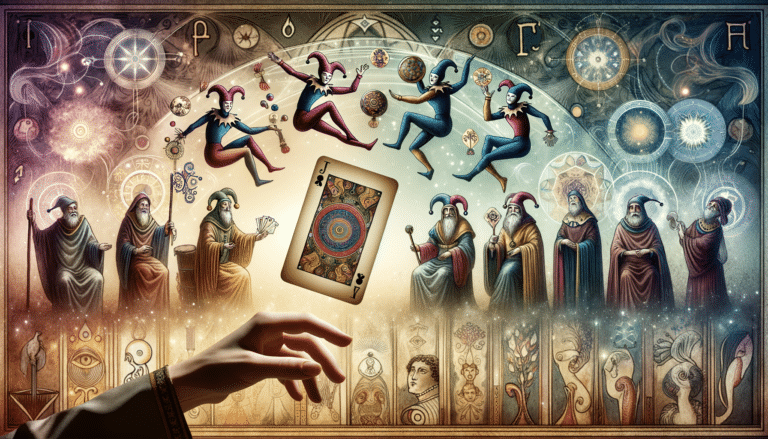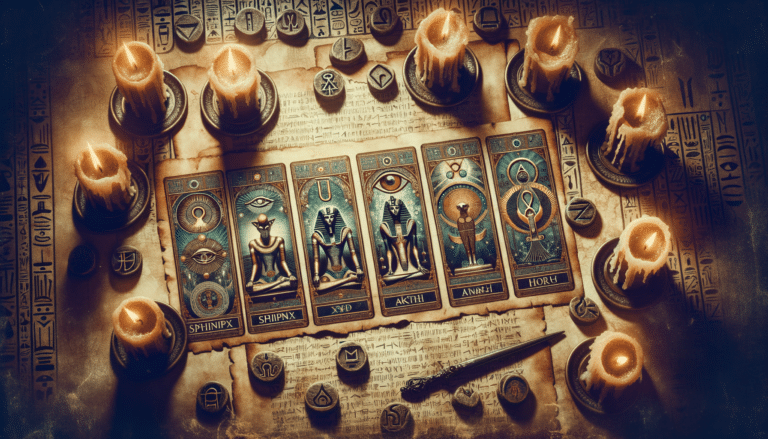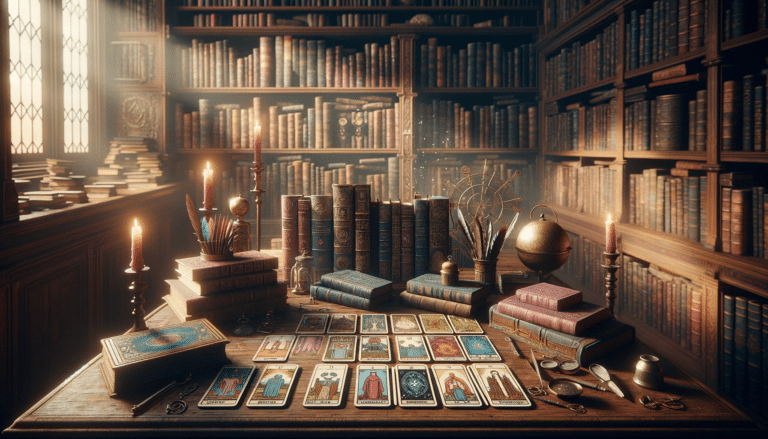The History of Tarot in Europe: Origins Revealed
You’d think Europeans had nothing better to do in the 15th century than invent tarot cards, but actually, it was a period rich with social and cultural evolution. As you delve into the origins and history of tarot in Europe, you’re peeking into a world where early card games were the rage among the upper classes.
The Visconti-Sforza deck, one of the earliest recorded tarot sets, emerged in the context of the Italian Renaissance, a time bursting with artistic and intellectual expansion. The Church’s influence loomed large, yet tarot managed to find a home both within and outside religious confines.
Initially, these cards weren’t for telling your fortune but for playing games. Over time, you’ll see how tarot’s use for divination purposes caught on, spreading tarot’s fame across Europe and transforming its nature through the centuries, especially during the occult revival of the 19th century.
Key Takeaways
- Tarot originated in Europe during the late medieval period as a result of the popularity of card games and the accessibility of woodblock printing.
- The Visconti-Sforza deck, one of the earliest known tarot card sets, was commissioned by noble families in Milan and reflected the artistic and cultural themes of the Italian Renaissance.
- Noble patronage played a crucial role in the development of tarot, allowing artists to blend traditional symbolism with contemporary art.
- Tarot in Europe was influenced by the customs and values of the time, incorporating Christian allegory, classical motifs, Eastern aesthetics, and esoteric symbols.
Early Card Games in Europe
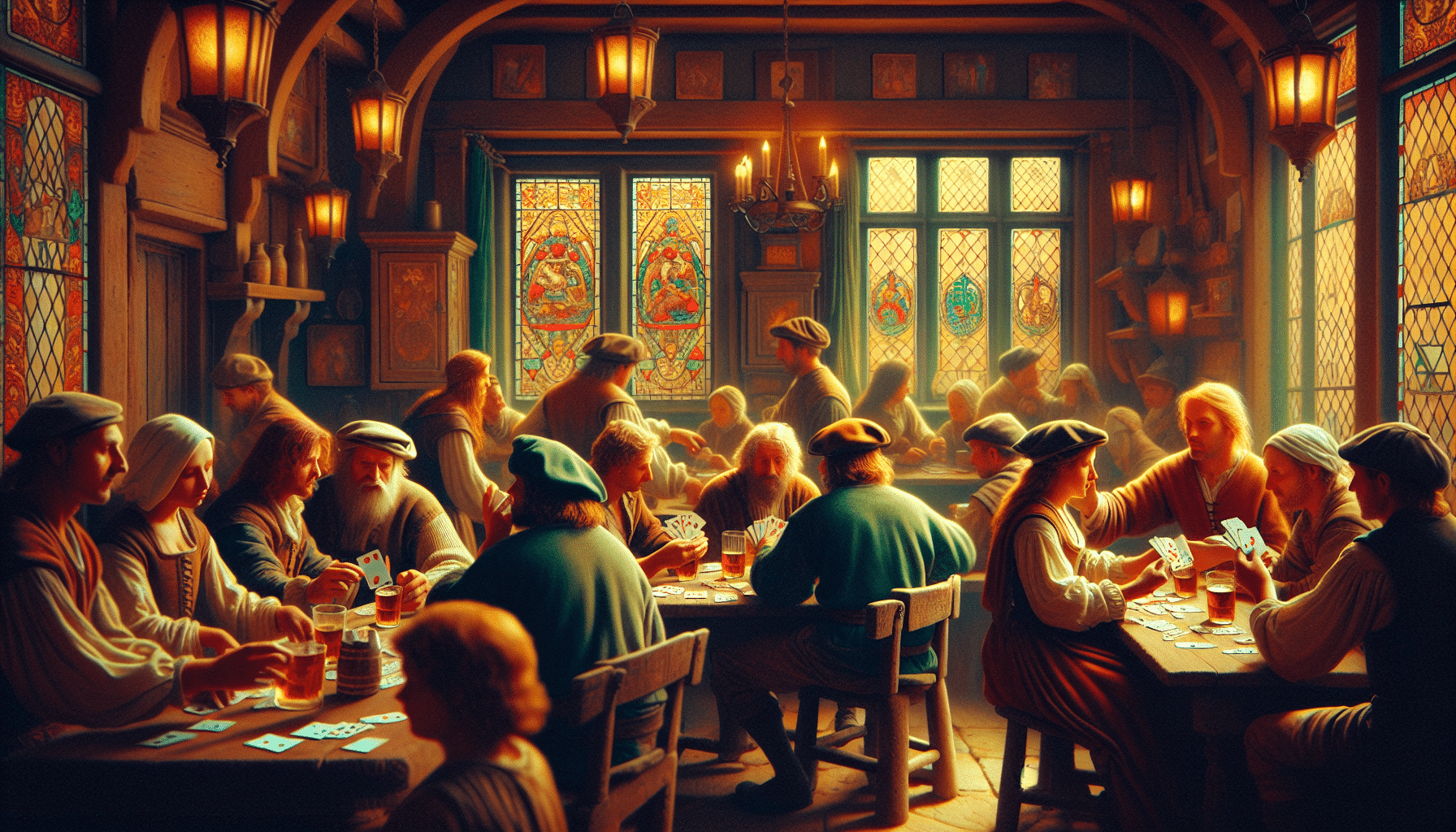
You’ll find that early card games paved the way for the development of tarot in Europe, with their origins tracing back to the late medieval period. These games weren’t just pastimes; they reflected cultural values and social dynamics of the times. Intriguingly, the card making materials used then were quite rudimentary compared to today’s standards. Initially, cards were hand-painted, which meant they were luxury items for the wealthy. However, with the advent of woodblock printing, cards became more accessible to the general populace.
This surge in popularity inevitably led to various gambling laws being enacted across Europe. You see, as card games spread, they became synonymous with gambling, and authorities sought to regulate or even ban their use to curb the associated vices. These laws shaped how card games evolved, with tarot emerging as both a tool for play and divination.
Understanding these historical nuances helps you grasp why tarot cards hold such significance. They’re not just remnants of a bygone era; they’re markers of Europe’s social and legal transformations. Plus, they remind you that what’s commonplace now, like a pack of cards, was once at the heart of cultural shifts and legal debates.
The Visconti-Sforza Deck
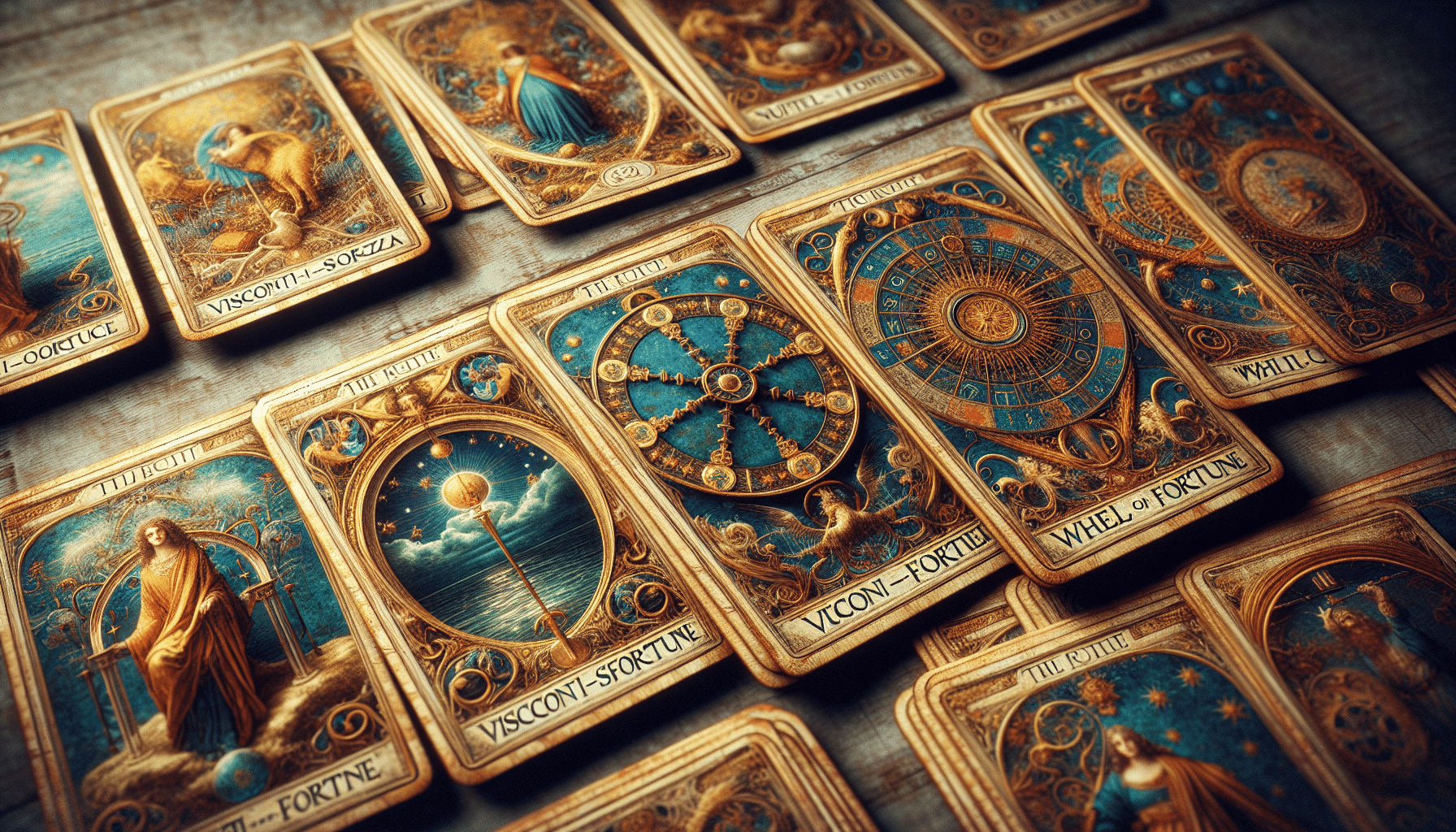
You’re about to explore the origins of the Visconti-Sforza deck, one of the earliest known tarot card sets.
Commissioned by a noble family, this deck’s rich iconography and symbolism reflect the era’s artistic and cultural themes.
Understanding its significance sheds light on why tarot has its roots deeply planted in European soil.
Earliest Tarot Cards
Delving into the history of tarot in Europe, you’ll find that the earliest known tarot cards hail from the Visconti-Sforza deck, crafted in the mid-15th century. These cards reflect a time when card manufacturing was an art form, with hand-painted designs that often bore the marks of aristocratic patronage.
The Visconti-Sforza tarot, commissioned by the ruling families of Milan, boasts intricate symbols and figures, blending Christian allegory with classical motifs.
Curiously, the Mamluk influence is discernible in the tarot’s early form. Playing cards, which predated tarot, were brought to Europe from the Islamic societies where the Mamluks had established a tradition of lavishly decorated card decks. This Eastern heritage subtly infused the imagery and style of the earliest European tarot, merging with local aesthetics to create a unique cultural artifact.
Noble Family Patronage
Amid the splendor of the Italian Renaissance, you find the Visconti-Sforza deck emerging as a product of noble patronage, with the ruling families of Milan investing in the creation of these lavishly illustrated cards. This was more than an aristocratic hobby; it was a statement of wealth and sophistication. By funding the arts, nobility could showcase their power and cultural prowess.
Here’s why the Visconti-Sforza deck is significant:
- Cultural Status: It symbolized the elevated social standing of the Milanese elite.
- Artistic Innovation: The deck was a canvas for Renaissance artists, blending traditional symbolism with ornate, contemporary art.
- Historical Legacy: It offers a glimpse into the customs and values of 15th-century Europe.
- Preservation of Arts: Noble patronage was crucial for sustaining artists and their craft.
You’re witnessing the interplay between power, art, and history – all through the lens of tarot.
Iconography and Symbolism
Often, you’ll notice the Visconti-Sforza tarot deck is rich in iconography and symbolism, reflecting the intricate belief systems and hierarchies of its time. This deck, a product of noble patronage, weaves together mystical archetypes with the prevailing cultural integration of the era. Each card serves as a visual compendium of medieval concepts, blending Christian imagery, astrological motifs, and societal roles into a tapestry of medieval life. These images weren’t just for show; they were contemplative tools that encoded wisdom and guidance.
As you delve into the cards, you’re engaging with a historical dialogue, one that bridges the gap between the spiritual and the mundane. The Visconti-Sforza deck isn’t just a collection of pretty pictures – it’s a mirror of its time, reflecting the complexities of European culture and spirituality.
Check out our Tarot Cards & Oracle Decks here…
Influence of the Italian Renaissance
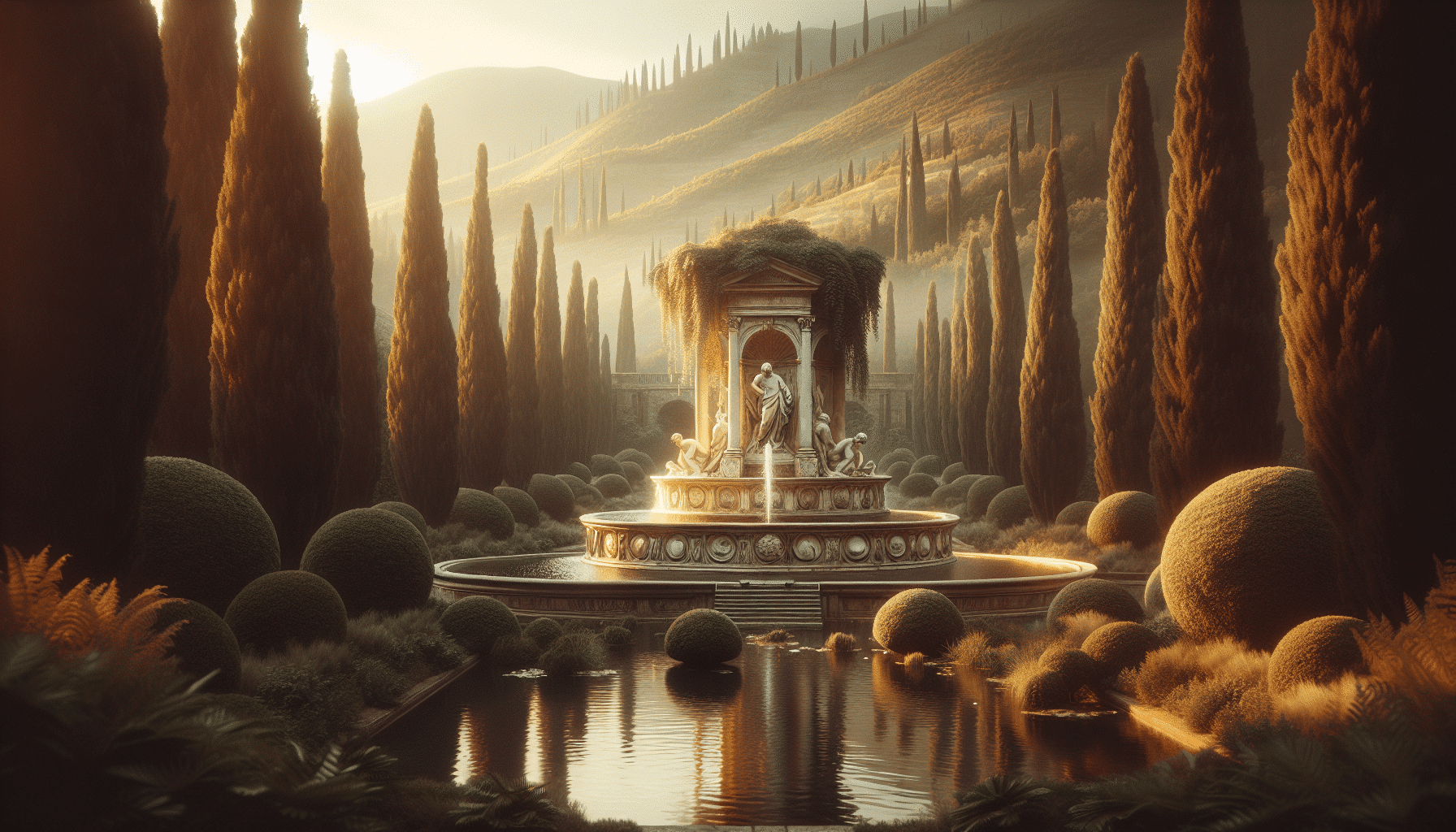
You’ll uncover that the Italian Renaissance played a pivotal role in the development of tarot as it swept through Europe, blending art, symbolism, and esoteric knowledge. This era, marked by a rebirth of classical philosophy and an explosion of artistic expression, provided the perfect cultural exchange platform for the nascent tarot tradition.
As you delve deeper, you’ll find that the Renaissance influence on tarot is multifaceted:
-
Humanism: Renaissance humanism shifted the focus toward individual experience and emotion, which is reflected in the personalized nature of tarot cards.
-
Artistry: The era’s emphasis on art and beauty is evident in the intricate designs and elaborate illustrations of early tarot decks.
-
Mysticism: With a renewed interest in the mystical and occult, tarot imagery began to incorporate esoteric symbols that resonated with seekers of hidden knowledge.
-
Patronage: Wealthy patrons often commissioned customized tarot decks, further driving innovation and diversity in tarot art and interpretation.
Understanding this context, you’ll appreciate how the Italian Renaissance wasn’t just a backdrop but an active catalyst for the evolution of tarot. It’s in the interplay of these elements that tarot found its voice and began to spread across the continent.
Learn more with these tarot books here…
Tarot and the Church
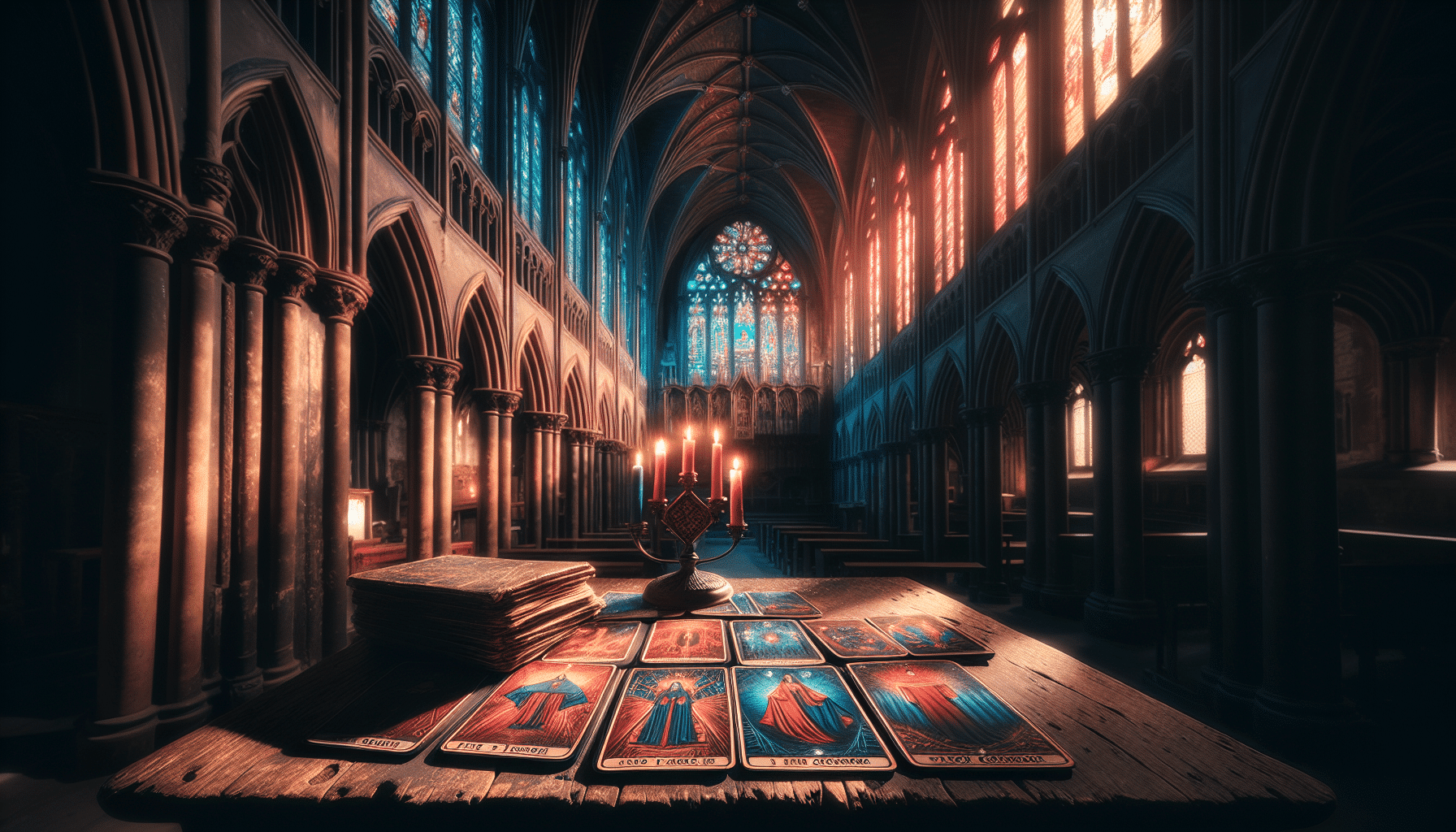
While the Catholic Church typically held a skeptical view of divination practices, you’ll find that tarot managed to flourish under the radar of ecclesiastical authority in Europe. The church’s power was vast, and yet, tarot readings and the cards’ mystical imagery wove themselves into the fabric of European culture. Despite the potential for church censorship, tarot’s adaptability allowed it to persist and even be embraced by certain individuals within the church.
You might wonder how tarot avoided the fate of other esoteric practices that fell victim to religious scrutiny. One reason lies in the cards’ dual-natured religious interpretations. Some tarot imagery borrows from Christian symbolism, which might’ve softened the church’s view of these tools. The cards weren’t just seen as instruments of fortune-telling but also as items bearing moral and spiritual lessons. The church, obsessed with heresy and the purity of belief, often missed the subversive undercurrents of tarot because they appeared cloaked in familiar religious garb.
Thus, tarot slipped through the cracks of potential church condemnation, finding a niche where it could survive and even thrive amid the religious landscape of Europe. It’s a testament to the tarot’s resilience and its ability to adapt to the cultural and religious climate of the times.
Learn even more secrets of history of tarot here…
Tarot for Divination Purposes
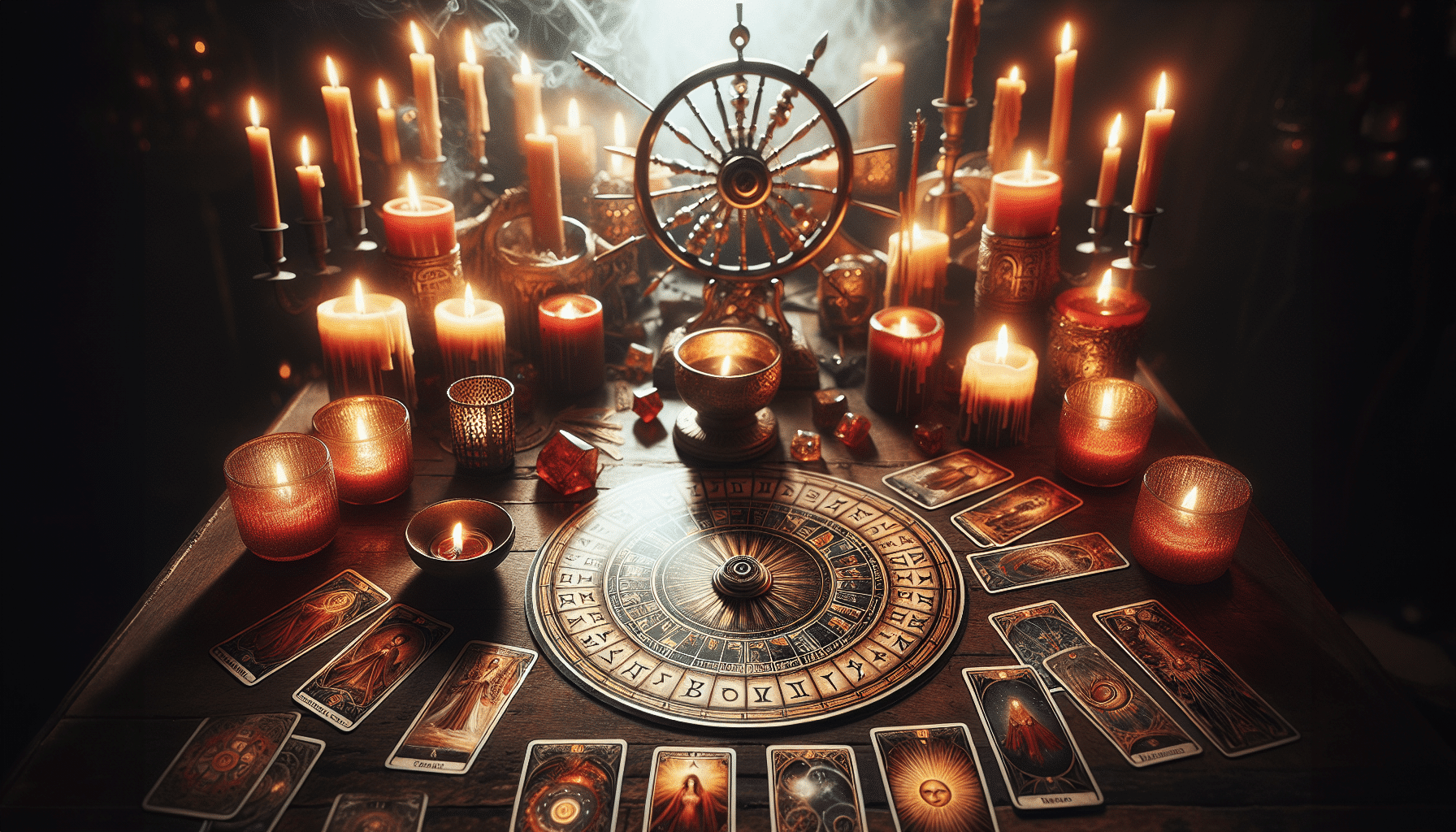
How, then, did tarot cards come to be used for divination, transcending their initial role as mere playing cards or moral guides? The journey from game to oracle is as intriguing as it’s complex. As you delve into the world of tarot, you’ll find that each card’s imagery and symbolism began to take on a mystical interpretation. This shift wasn’t abrupt but rather a gradual adoption by those who saw in the cards something beyond the superficial.
In the hands of the right person, tarot cards became a tool for psychic readings, unlocking insights and offering guidance. Here are a few key reasons why tarot became synonymous with divination:
-
Symbolic Richness: Each card contains a multitude of symbols, allowing for deep interpretative potential.
-
Cultural Shifts: Over time, society became more open to esoteric practices, paving the way for tarot’s mystical use.
-
Psychological Insight: The cards often reflect personal life experiences, providing a mirror to one’s subconscious.
-
Ritualistic Appeal: The process of laying out and interpreting the cards can be a meditative practice, creating a ritual that many find spiritually fulfilling.
Understanding tarot for divination purposes means embracing its capacity to blend art, psychology, and spirituality into a singular, transformative experience.
Spread of Tarot Across Europe
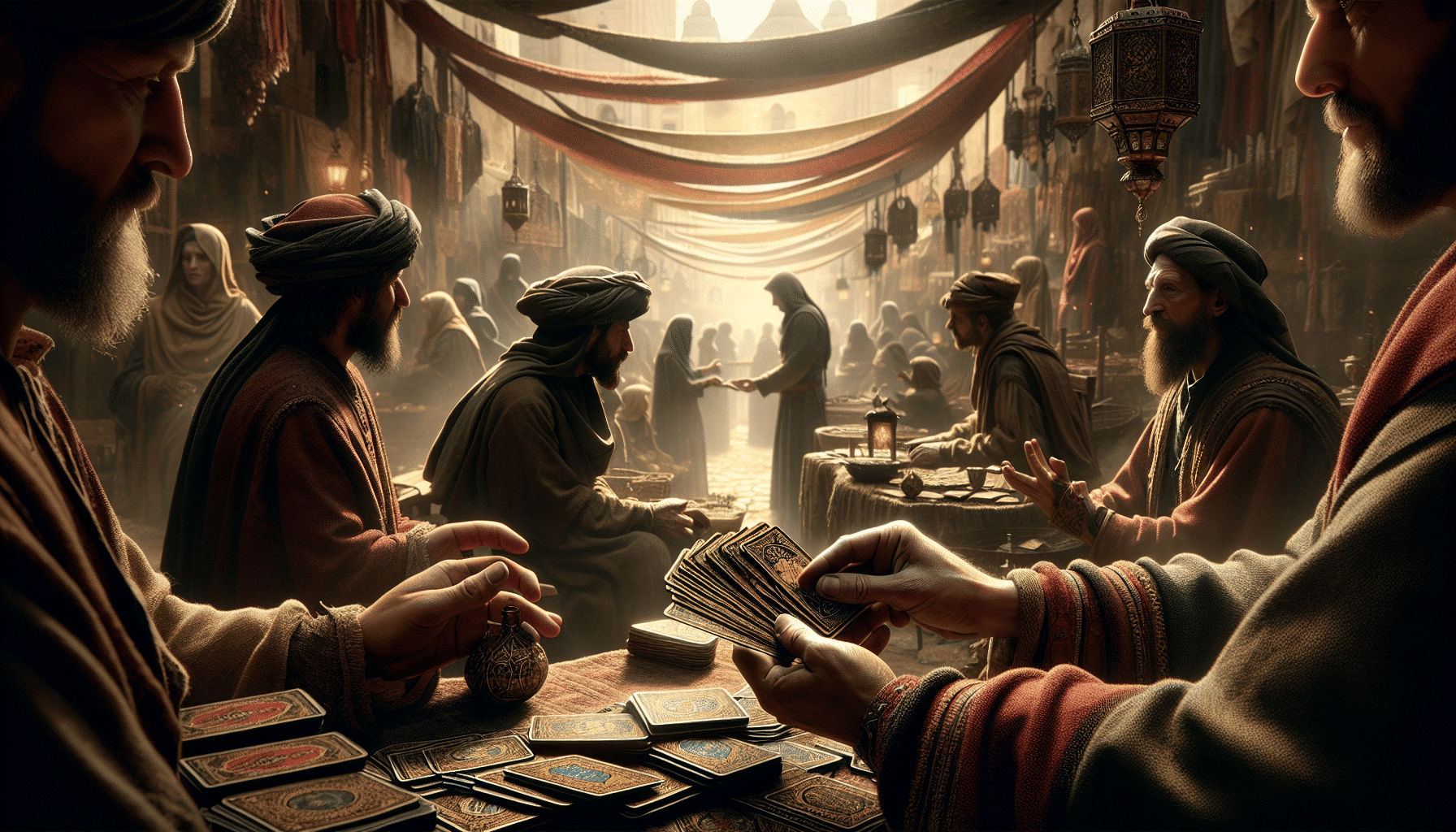
Tarot’s journey across Europe was propelled by the card game’s popularity, as you trace its expansion from Italian courts to the far corners of the continent. Initially, these cards were luxury items, hand-painted and reserved for the wealthy. But as demand grew, they began to be produced more widely, reaching a broader audience.
Cultural exchanges played a significant role in the spread of tarot. As nobles traveled, they brought their tarot decks along, introducing the game to new territories. The fascination with tarot wasn’t just among the aristocracy; it soon caught on with the public at large. As the game’s popularity soared, it wasn’t long before tarot decks crossed borders with ease.
Moreover, trade routes were essential in tarot’s dissemination. Merchants would carry decks alongside their usual wares, selling them in bustling markets and distant lands. Each region added its unique flair to the tarot, creating an array of distinct styles and interpretations that reflected local cultures and traditions.
Tarot’s Transformation Over Centuries
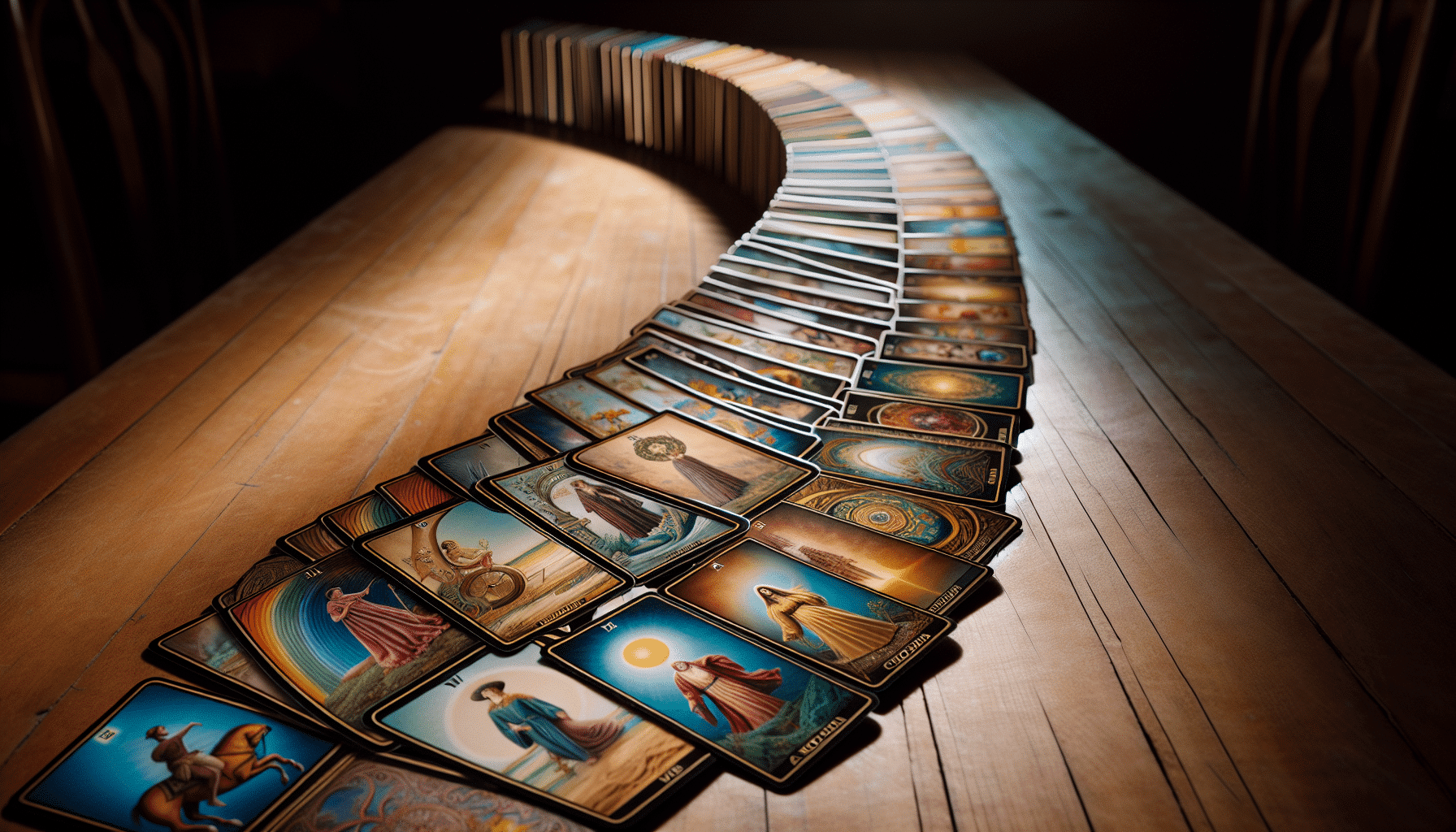
You’ve seen how tarot spread across Europe; now let’s explore its evolution over the centuries. Initially, tarot decks were hand-painted, making them the privilege of the aristocracy. However, with the advent of card manufacturing techniques, such as woodcut and later lithography, tarot cards became more widely available.
As tarot’s availability increased, so did its uses. Originally used for games, the cards underwent a divinatory evolution, gaining mystical significance. By the 18th century, tarot was entrenched in the world of occult and esoteric knowledge, with comprehensive systems for interpretation emerging.
To understand this transformation, consider these key points:
- The shift from handcrafted to mass-produced decks allowed broader access and new applications.
- Tarot’s integration into occult practices reflected the period’s fascination with mysticism and the supernatural.
- The development of standardized meanings for cards facilitated the divinatory evolution.
- Variations in tarot imagery and symbolism reflect cultural influences and the changing contexts in which tarot was used.
This evolution reflects tarot’s remarkable adaptability and its ability to capture the human imagination, offering insight into both the future and the collective unconscious of the age.
The Occult Revival of the 19th Century
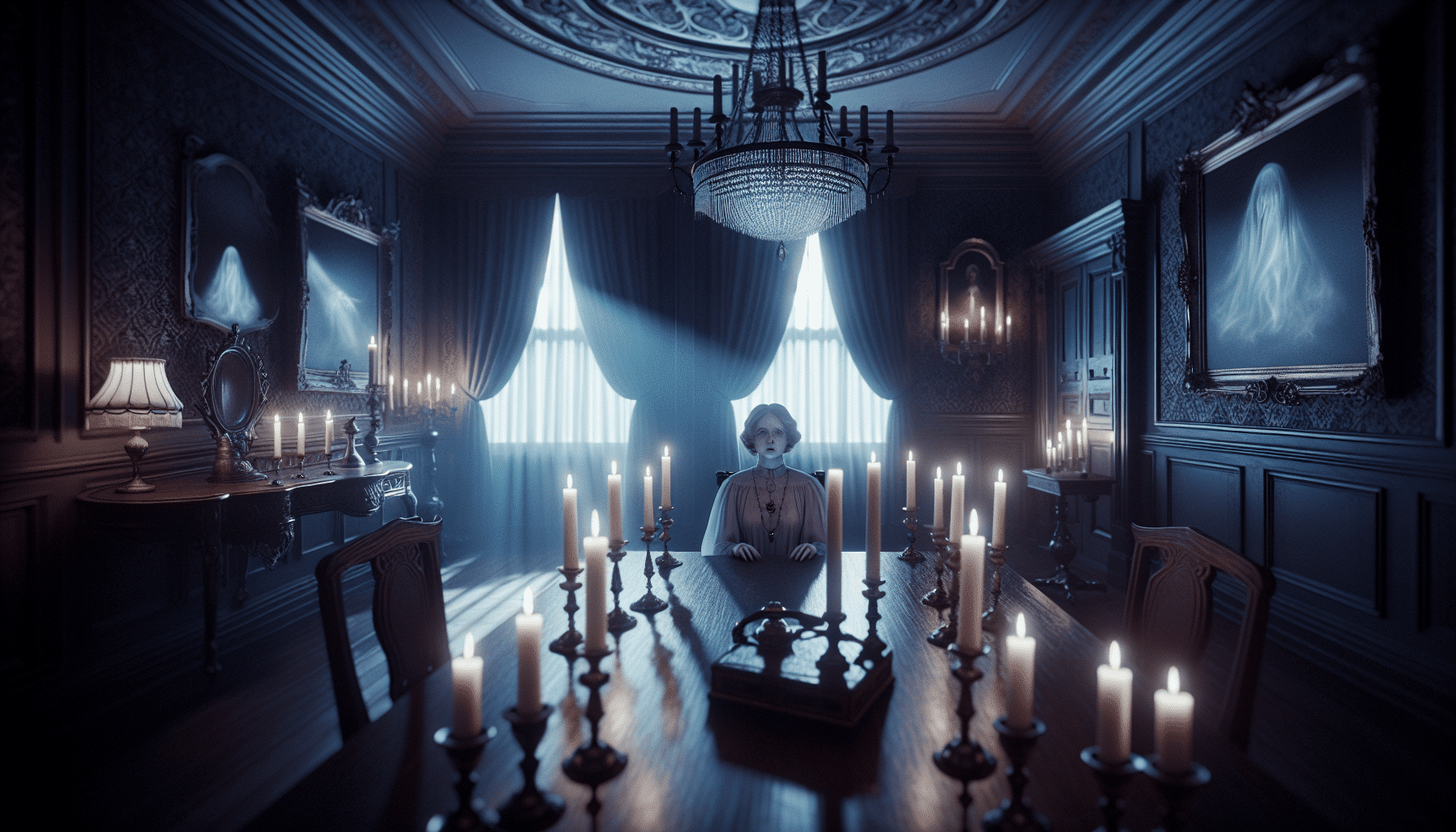
The fascination with the mystical and supernatural that marked tarot’s earlier transformation found new momentum during the Occult Revival of the 19th century. This period reignited interest in mystical practices, including tarot, astrology, alchemy, and the newly emergent Spiritualism movement. You might wonder how this revival influenced tarot’s evolution and significance.
Well, during this era, the veil between the tangible and the ethereal seemed thinner than ever. People were eager to explore beyond the material world, and tarot offered a tangible way to delve into the mystical. The cards became more than just a game; they were tools for divination, a means to communicate with the spiritual realm, and a method for self-exploration.
The Spiritualism movement particularly fueled this drive. It suggested that communication with the dead was possible, and tarot became one of the mediums through which these otherworldly conversations took place. Mediums and spiritualists often employed tarot cards during séances, adding to the cards’ mystique and their association with the occult.
As you imagine the dimly lit parlors of the 19th century, filled with the curious and the hopeful, remember that tarot’s journey is deeply entwined with humanity’s quest to understand the unknown. The Occult Revival was a chapter that significantly shaped the narrative of tarot in Europe, cementing its place in the world of mystical practices.
Conclusion
As you’ve journeyed through tarot’s tapestry, woven with threads of medieval intrigue and Renaissance wisdom, remember it’s a mirror reflecting Europe’s soul. From aristocratic salons to hushed church halls, it captured imaginations, evolving with each hand it touched.
Tarot’s story is your story, a deck of endless possibilities, reshuffled by time. In the occult revival’s flickering candlelight, find its true magic – guiding not just fortunes, but the quest for self-understanding across the ages.

About The Author – Allen Hill
Allen Hill, the force behind Unknown Truth Tarot, has a YouTube following 6-times bigger than the population of his hometown, Miamisburg, Ohio. From his spiritually rich blog on Tarot and crystals to his role as CEO of The Unknown Truth Tarot Metaphysical Shop, Allen’s passion for the metaphysical shines through.
A master Tarot reader and “crystal junkie,” Allen is also a devoted dad to Dylan, 10, and Destiny, 24. When he’s not immersed in the world of Tarot and crystals, he enjoys poker and video gaming sessions, often humorously outplayed by Dylan.
Follow Allen on Twitter, Instagram, Facebook, TikTok, and subscribe to his Unknown Truth Tarot YouTube channel to join him on a journey of spiritual growth and self-discovery.

